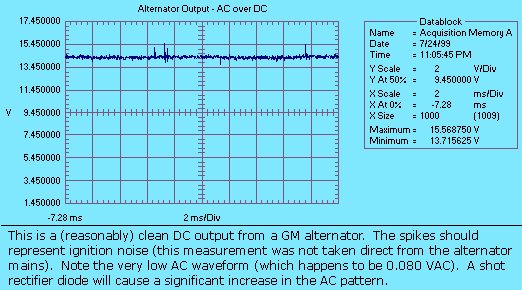Diagnosing your Alternator with a DVM or Scope

| Last modified 2005 APR 07 04:37:57 GMT |
This document isn't complete - I'll be adding to it as I get the time to do it right. In the meantime, you can see a comparison of the output of a properly operating alternator and a defective one, as well as some simple DVM tests to check whether you're suffering from a failed rectifier.

Noise can commonly come from dirty/pitted commutator or conductive material being in the interspacings between the commutator bars. Disassembly and cleaning of the commutator (using a "ScotchBrite" pad or other non-metalic abrasive) and cleaning of the interspacings can reduce noise. Unless severe, the noise is nothing to fret about -- you're looking for a basically level DC signal.

Another insight here is that the reading with the blown rectifier has a lower voltage. That's just a byproduct of the shorted wave - the more important thing is that this signal clearly has an AC signal riding on it, and that isn't good news.
Note that even if you don't have a scope, you can check for the above condition with a regular DVM - connect it to a suitable voltage source (preferably NOT at the battery - instead, try the alternator mains, someplace on the fuse panel, or, my favourite, the cigarette lighter - the alternator (source) being the most accurate, but generally the biggest pain to get to), then check the DCV output, which should be approx 13.4 VDC with the engine running, although it may be up to a volt or more higher than that if the alternator is hard at work charging the system. Now, switch the DVM to ACV (if DCV and ACV are not adjacent settings on the meter, DISCONNECT the metre before switching it). If the ACV reads anything above perhaps 0.5VAC, you've got a really NOISY alternator, but still one whose rectifier bridge is working properly. If, OTOH, the ACV figure is up around what the previously measured DCV reading was, the rectifier in your alternator is not properly converting the three-phase into DC (summing and "clipping" the three AC phases), and your alternator is outputting A/C, which means the rectifier is shot and you should repair/replace the alternator.
The car may seem to run just fine under this condition (since DCV is present, just really noisy), but things aren't right. If the car was intended to run off of three phase AC, they wouldn't bother with the rectifier in the alternator to begin with. I'd even wager that your battery will suffer greatly if you continue to operate the automobile with an alternator in this state.
Below, I attempt to present an image of the three-phase waveforms as generated by the automotive alternator:
This image represents a three-phase AC waveform - much like what your alternator outputs. The horizontal line down the middle represents 0 Volts, and the yellow line along the top represents the DC voltage as clipped by the rectifier diode bridge (which clips out negative voltages, and sums the voltages together). The "ripple" nature of the DC is expected, and is cycling very fast, so this ripple isn't nearly as apparent as this closeup waveform might make it seem. In cases where there is significant AC ripple (showing a volt or more when measured with a DVM in AC mode), your alternator needs servicing.
The frequency of the sine wave is directly related to the rotational speed of the alternator -- a faster rotation results in a higher frequency - and in turn, a more stable DC voltage (since the duration of the spikes are briefer).
Should one of the diodes go bad - and it starts passing negative voltages (a shorted diode), or not passing voltage at all (an open diode), then the waveform will change:
This is an apparent OPEN. Note that one of the phases appears to be missing entirely. While the DC signal appears very similar to the one below, the AC signal WILL appear different if viewed on an oscilloscope, and also, this failure shouldn't result in a current drain by the alternator.
This is an apparent SHORT. Note that all three phases are present, just that one of them is affecting the voltage output even when it is in the negative cycle -- which results in the 0VDC output cycle evey 1/3 cycle. This may not be apparent when viewed by a DVM in DC mode. Note that this failure should be accompanied by the dashboard warning indicator and will in all likelyhood also produce a significant current draw both when the engine is running -- AND when it is off.
Mr. Fix-It has an article on Alternators. While not Jaguar-specific, it represents a good starting point for learning what to look for in diagnosing an alternator.
Sean B. Straw
EMail to: Sean.Straw+Jaguar@mail.professional.org
